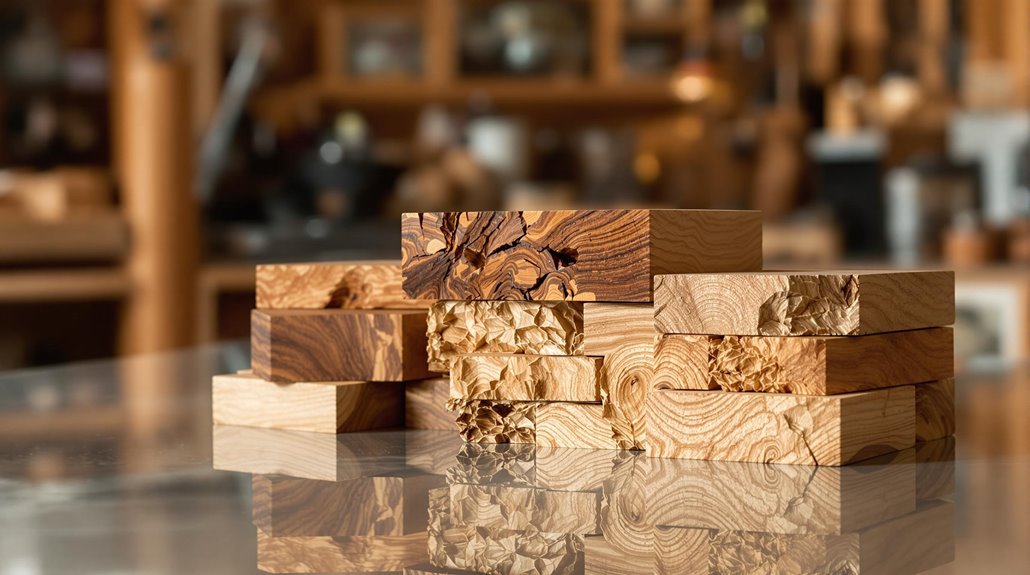The best solid wood for furniture depends on factors like durability, aesthetics, and versatility. Hardwoods such as oak, maple, walnut, and cherry are preferred due to their strength and resistance to wear, making them suitable for high-traffic items. Oak offers exceptional durability, while walnut combines durability with unique grain patterns. Maple is another strong choice, providing a clean aesthetic. Teak is ideal for outdoor use due to its moisture resistance. Considering sustainable sourcing and long-term value is also essential, as solid wood can retain or even increase in value over time, allowing for insightful choices ahead.
Key Factors in Choosing Wood
Selecting the right wood for furniture is a critical decision that greatly impacts both the functionality and aesthetic appeal of the final product. Key factors in this selection process include strength, stability, workability, and availability. Hardwoods, such as oak and walnut, are favored for their durability and wear resistance, making them ideal for weight-bearing applications. Stability is essential to prevent warping, particularly in larger surfaces, while moisture resistance plays a role in maintaining the integrity of the furniture. Additionally, the wood's workability must align with construction techniques and tools, influencing the ease of fabrication. Finally, sourcing locally not only contributes to sustainability but also affects cost, emphasizing the need to balance quality and budget in the decision-making process.
Overview of Popular Woods
An examination of popular woods reveals significant differences in durability, hardness, aesthetic appeal, and versatility. Hardwoods such as oak and maple are known for their exceptional durability and resistance to wear, while cherry and walnut offer unique visual characteristics that enhance furniture design. Understanding these factors is essential for making informed decisions about material selection in furniture construction and design.
Durability and Hardness Comparison
When evaluating the durability and hardness of popular woods for furniture, several key species stand out due to their unique characteristics. Oak is renowned for its heft, offering substantial durability and resistance to warping, making it suitable for cabinetry and kitchen furniture. Maple, with its hardness rating of approximately 1,450 lbf, excels in heavy-use items, maintaining integrity over time. Cherry, while slightly softer at 995 lbf, provides durability and develops an appealing patina as it ages. Walnut, rated at around 1,010 lbf, combines high durability and aesthetic appeal, often used in high-end furniture. In contrast, softwoods like pine and cedar, though less dense and durable, can still be viable options with proper maintenance, particularly for outdoor applications.
#
Aesthetic Appeal and Color
Although the choice of solid wood markedly impacts furniture durability, its aesthetic appeal and color also play crucial roles in design and style. Woods such as oak showcase beautiful grain patterns, with white oak presenting a gray-brown hue and red oak offering a reddish cast. Cherry features a rich reddish-brown tone that ages beautifully, while walnut is recognized for its chocolate brown color with dark streaks, ideal for fine furniture. Mahogany, known for its luxurious deep red appearance, adds elegance, whereas maple provides a clean, contemporary look with its straight grain. Unique grain patterns, like birdseye and quilted textures, further enhance the visual interest, demonstrating that solid wood not only serves functional purposes but also enriches aesthetic value in furniture design.
Versatility and Usage Options
The versatility of solid wood in furniture making is underscored by its wide range of usage options, catering to various styles and functional requirements. Walnut and hard maple, with Janka ratings of 1010 and 1450 respectively, are favored for high-quality furniture. White oak, resistant to decay, is commonly used in cabinetry and flooring, while mahogany serves well in decorative pieces and veneers. Acacia, with a notable Janka score of 1750, adapts to both indoor and outdoor applications. Additionally, maple's ease of workability makes it ideal for dining sets, whereas cedar's moisture resistance makes it suitable for outdoor furniture. Each type offers distinct characteristics that enhance its utility in furniture design.
Durability and Hardness Ratings
Understanding the durability and hardness ratings of various woods is essential for selecting the right material for furniture. The Janka hardness test provides a measurable standard, indicating how well wood can withstand dents and wear, which is particularly important for high-traffic items such as dining tables and chairs. By comparing the hardness ratings of hardwoods like oak, maple, and walnut, we can make informed decisions about their suitability for different furniture applications.
Janka Hardness Ratings Explained
As wood selection becomes increasingly important for furniture makers and homeowners alike, the Janka hardness scale serves as an essential metric for evaluating the durability and performance of various wood species. Developed by Gabriel Janka in the early 1900s, this scale quantifies wood hardness by measuring the force required to embed a 0.444-inch steel ball into the wood surface. The resulting ratings, expressed in pounds-force, kilograms-force, or newtons, provide valuable insights into wood's suitability for various applications. Factors such as density, moisture content, and growth patterns greatly influence these ratings. Generally, higher Janka ratings indicate greater durability, making them vital for selecting appropriate materials for high-traffic areas like flooring and furniture that endure daily wear and tear.
Comparing Durability of Woods
How do different wood species compare regarding durability and hardness? Hardwoods, such as oak and maple, are generally denser and more durable than softwoods, making them suitable for high-use items. For instance, hard maple has a Janka hardness rating of 1,450 lbf, indicating its strength for dressers and kitchen cabinets. Oak is robust, often used for tables and cabinets. In contrast, softwoods like pine, with a Janka rating of 950 lbf, offer decent durability but are less resistant to damage. Teak stands out for its moisture resistance, ideal for outdoor furniture, while cedar and cypress, although less dense, are viable for decorative pieces. Ultimately, wood choice should consider environmental conditions and intended use for maximum longevity.
## Aesthetic Appeal and Color
While the choice of solid wood for furniture often hinges on durability and functionality, the aesthetic appeal and color of different wood types play a crucial role in defining the overall ambiance of a space. Oak, with its rugged look and visible grain patterns, adds rustic charm, while walnut offers a rich, dark hue that conveys sophistication. Maple presents a clean, contemporary appearance, ideal for minimalist designs, whereas mahogany's luxurious reddish-brown tone and quilted grain enhance high-end furnishings. Each wood type's unique grain, such as the straight grain of maple or the figured grain of walnut, contributes not only to visual interest but also to the character of the furniture, making these choices essential in interior design.
Versatility in Furniture Design
Solid wood furniture exemplifies remarkable versatility in design, adapting seamlessly to a wide array of styles and functions. Its natural beauty enhances rustic environments, while clean-lined solid wood pieces complement contemporary spaces. Traditional decor benefits from the timeless elegance and detailed craftsmanship of solid wood, adding depth and character. Furthermore, solid wood is ideal for multifunctional furniture, supporting designs that integrate storage or modular capabilities, particularly advantageous in urban living settings. The material enables the creation of furniture that serves various purposes without sacrificing aesthetic appeal. Additionally, solid wood allows for artistic expression through sculptural forms and intricate joinery, transforming functional pieces into artistic statements that enrich any interior design. This adaptability underscores solid wood's prominence in furniture design.
Cost and Availability Considerations
When considering furniture made from solid wood, the interplay of cost and availability plays an essential role in the selection process. Hardwoods, such as mahogany, oak, and walnut, are typically more expensive due to their density and the longer growth periods required for mature trees. The availability of these woods can fluctuate, with rarer species commanding higher prices. Additionally, the longer seasoning times for hardwoods and the increased labor costs associated with their density further elevate their market value. Larger furniture pieces necessitate more material, driving up costs, while custom sizes and complex designs add additional expenses. Although the initial investment in solid wood furniture is higher, its durability and potential for refinishing offer long-term value, reducing overall maintenance costs.
Sustainable Wood Options
As the demand for environmentally friendly furniture options increases, sustainable wood choices are becoming increasingly important for both consumers and manufacturers. Bamboo, although technically a grass, is a leading option due to its rapid growth and minimal resource requirements. Reclaimed wood, salvaged from old structures, not only conserves natural resources but also adds unique character to furniture. Among hardwoods, varieties like oak and teak are favored for their durability and aesthetic appeal, with oak being particularly resistant to wear. Other sustainable hardwoods, such as Black Locust and Accoya wood, offer additional benefits, including decay resistance and a lower carbon footprint. These options illustrate the diverse range of sustainable materials available for furniture production today.

